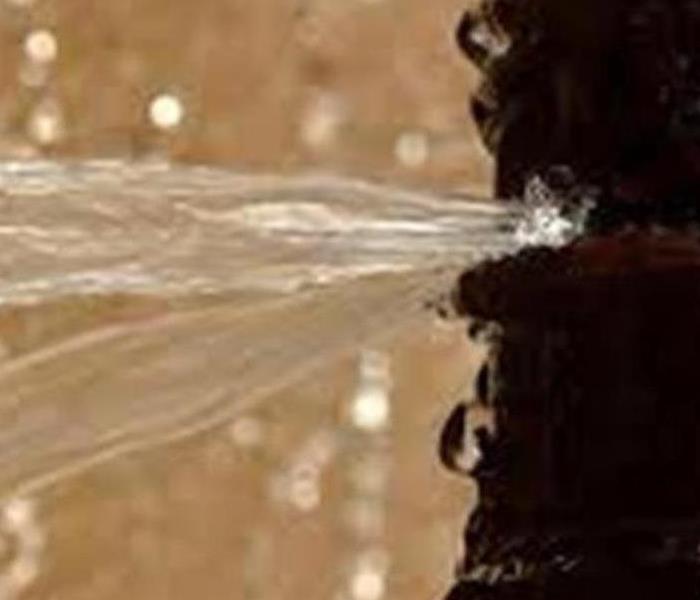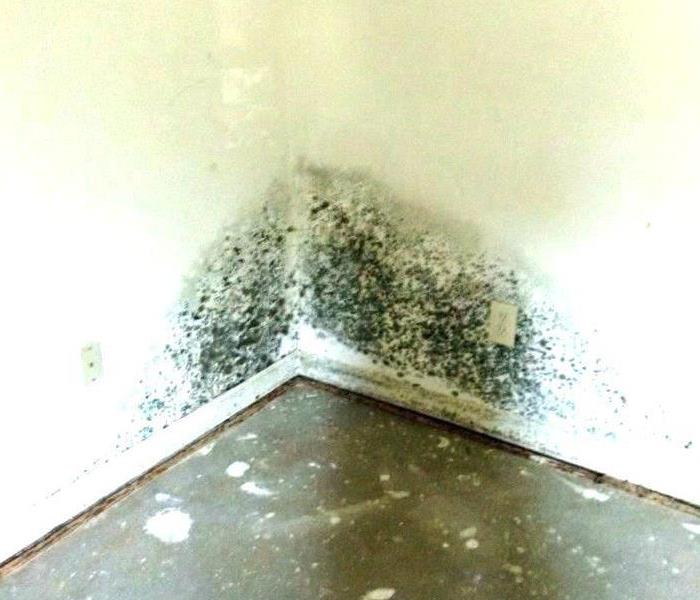Archived Water Damage Blog Posts
Is a Flooded Basement Covered by Insurance?
11/9/2022 (Permalink)
 Does insurance cover a flooded basement?
Does insurance cover a flooded basement?
Basement Flooding and Insurance Coverage
If a pipe bursts in your basement and floods your home, this is considered a water loss, which is covered by your homeowner’s insurance. However, if the pipes burst because of negligence or neglect on your part (like leaving a faucet running) then this might not be covered under most policies.
Basement flooding may also be covered if it was caused by an outside source like heavy rains or even certain types of natural disasters such as hurricanes or earthquakes.
Another thing to keep in mind when dealing with basement flooding: some damage isn't always obvious right away—and sometimes it can be very expensive to fix! For example, mold can develop after a flood has occurred—and this can cause serious issues for anyone living in that environment long-term.
What Can Be Done to Prevent Basement Flooding?
There are several things you can do to keep the water out of your basement. One way is to install a backwater valve, which prevents floodwaters from backing up through your sewer lines into your basement during heavy rains or flooding. Another option is to install a sump pump in your basement floor, which will pump out any water that seeps in through cracks and crevices in the walls; this is especially helpful if you live near a river or lake and have experienced flooding before. A third option is updating any drains or pipes around your home, so they don't leak when there's heavy rain; it's also important to make sure that any drain covers are sealed properly so no water leaks out from underneath them.
What Should You Do If You're Not Covered?
If you have not been covered by your insurance company, or if you have and they will only cover a portion of the repair costs, it's time to call in the professionals.
You should start by contacting a flood restoration company to see what their services would cost and whether they can help with any other parts of your home that may have been damaged during this event.
It's important to note here that while there are companies out there willing to take on water damage jobs at low rates, these contractors may not be licensed or insured professionals who can deliver quality results. You want someone who has extensive experience dealing with different types of insurance claims after major floods as well as experience restoring properties affected by such events, such as SERVPRO of South Garland.
A flood in your basement is bad news, but an insurance policy could save you.
A flooded basement is not just a pain in the neck, it’s also expensive. In addition to all your belongings being destroyed and damaged, you have to pay to have them cleaned and dried out—not to mention pay for repairs on any items that aren’t covered by insurance.
But what happens if your home insurance policy doesn’t cover water damage? Luckily, most policies do offer coverage for flood damages when certain conditions are met. That said, if you want to make sure that your home is protected against any potential flooding incidents going forward then you should consider purchasing additional coverage through a rider or floater policy.
The best way to learn whether your basement flooding was caused by an act of nature or someone else is by talking with an insurance agent or restoration professional who can help guide you through the process.
If the thought of a flooded basement makes you nervous, don’t worry—there are some steps you can take to mitigate the risk. A good first step is to contact your insurance company and ask about flood coverage in case of basement flooding. If they don’t cover this type of loss, see if they have any other suggestions for how to protect your home from water damage during a storm. For example, homeowners can purchase flood insurance through FEMA or their local municipality which will provide them with protection against future flooding events.
5 Tips to Prevent Water Damage in Your Home
7/12/2022 (Permalink)
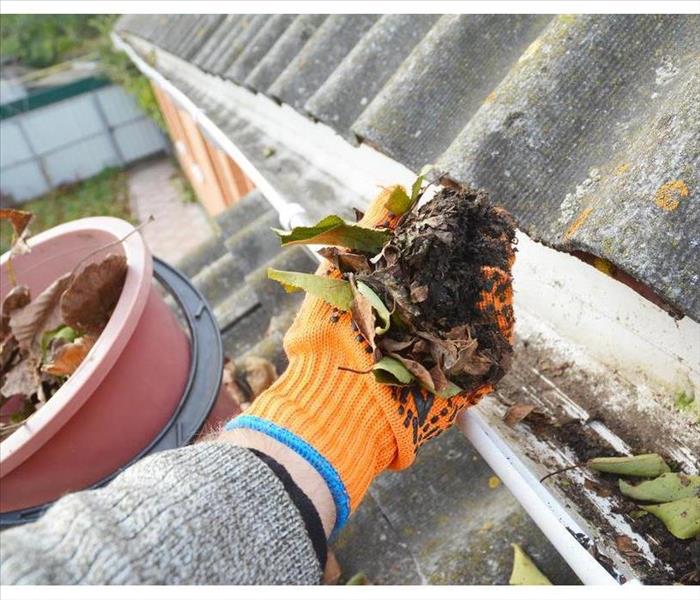 Clean out your roof gutters
Clean out your roof gutters
Five Easy Tips for Preventing a Flood In Your Home
SERVPRO of South Garland is always there for you when there is a water loss in your home, but do you know what is easier and much less of a headache?
Well, the answer is preventing the water from leaking in the first place. Here are 5 easy tips for preventing a flood in your home.
1. Never pour Grease down your drain
I am sure you have heard this before, but some people still will tell you that it is safe if you flush it with hot water, or mix dish soap with it. While that may eliminate some of the risk greases may still stick to the pipes eventually causing significant damage or a blockage. The safest thing you can do is pour your grease into an old can and let it harden in the refrigerator. Then you can just toss it into the trash it is easy and no worries in the pipes.
2. Do not use unclogging chemicals use a Drain Snake instead.
No matter how clean you are, the fact remains that hair and other debris will get into your drains and will cause blockages. This drives most people to grab a drain cleaning chemical, but what most people do not realize is how much these chemicals eat away at your plumbing and can cause leaking drains. so an alternative is a drain snake that is relatively inexpensive at a local hard wear store. This will eat up most all clogs and will be safer for your pipes than drain cleaning chemicals.
3. Watch where you plant
Some plants and trees, like weeping willows, have pretty invasive roots. If you’re not careful, they’ll grow right into your sprinkler system, drainage field, pipes, and septic tanks. Plan before you plant to keep roots away from any water lines.
4. Clean Out Roof Gutters
You know it’s on your to-do list anyway, so if you can, take a safe climb up to your roof next Sunday and check out your gutters. If you’re seeing lots of leaves, birds’ nests, sticks, and whatnot up there, your gutters may not be doing the job you hired them for. And on a rainy day, a clogged gutter can send water spilling into your home’s foundation, through the roof, or down to your basement. That could cause some serious water damage! So next time you’re doing some seasonal cleaning, make sure those gutters are clean. And if your gutters are too high, be safe and get a professional to check them.
5. Keep an Eye on Your Water Bill
With so many water pipes hidden behind walls and on the floors in your house, you might not know there’s a leak until the damage is done. That’s why it’s a good idea to keep a close eye on your monthly water bill. If you see it starting to creep up or get one that’s uncommonly high, it’s a pretty good sign that you may have a leak somewhere.
3 Examples of Secondary Water Damage
5/10/2022 (Permalink)
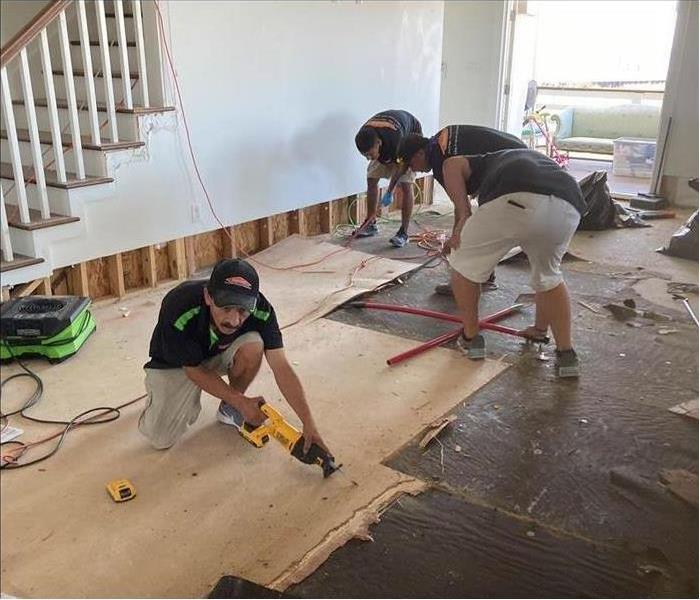 To be safe after a flood, pull up all of the floorings and replace them with something new.
To be safe after a flood, pull up all of the floorings and replace them with something new.
3 Secondary Water Damage Examples
If you have a flood in your Lakeview, TX, home, you don't only have the standing water to worry about. You also have to be mindful of potential secondary damage issues caused by the water. Here are three examples of secondary water damage.
1. Black Mold Growth
Mold can start to grow in as little as 24 hours when there is moisture and high humidity. Simply removing the water isn't enough after a flood. To ensure that mold doesn't grow, you must dry everything out as thoroughly and quickly as possible. If the water has been standing for more than a day, you'll want to call a water damage restoration specialist to assess the damage and repair your home. You will likely find that you have black mold behind the drywall, and the professionals will know how to safely remove it.
2. Wood Rot
When wood gets wet, it can take a very long time to dry out. If the wood is quickly dried out, you likely won't have to worry about wood rot. However, if the wood sits for even a few hours in floodwater, you could find that it absorbed too much water to properly dry out before it starts rotting. If you don't replace the rotting wood in your home, the structure's integrity could suffer, so you never want to ignore it. A professional will cut out the rotted wood and replace it with new, healthy wood.
3. Flooring Damage
Many flooring materials will lose shape when they get saturated with water and will never return to normal, despite how long you let them dry out. Water can also get trapped under the flooring materials, and the wet, dark place is a perfect environment for black mold growth. To be safe after a flood, pull up all of the floorings and replace it with something new.
Depending on how long the water sits in your Lakeview, TX, home, you could have a lot of secondary water damage. However, when you rely on professionals to help you with the clean-up, the situation is much easier to handle.
How To Prepare a Business Continuity Plan
3/1/2022 (Permalink)
 Creating a business continuity plan is critical for protecting your organization in the event of a major disaster
Creating a business continuity plan is critical for protecting your organization in the event of a major disaster
Steps For Developing a Business Continuity Plan
If you own a business in Towngate, TX, creating a business continuity plan is critical for protecting your organization in the event of a major disaster, such as a hurricane or fire. Having a well-documented plan will ensure that your business can continue during difficult times and that you can mitigate losses.
1. Perform an Analysis
One of the first steps for creating a business continuity plan is taking a step back and conducting a Business Impact Analyst to determine the impact that a catastrophic event could have on your business. While performing this analysis, you should identify the critical functions of your business and the necessary resources and to support them. Use surveys and questionnaires to gather this information.
2. Create and Document Recovery Strategies
Using the information from the BIA surveys, you should record and document all essential processes needed to keep your business operating. These strategies are should take all necessary equipment, materials and people required to maintain operations into consideration. Facilities and technical resources should be included as well. Conduct a gap analysis to identify the gaps between the current state and your business’s capabilities in a recovery state.
3. Develop a Formal Plan
Compile all information into one formal document that includes an emergency response plan, any relocation plans and disaster recovery procedures. Any recovery teams that have been formed to execute this plan should be outlined in the document, in addition to the contact information of any vendors required to assist with recovery, such as professional flood cleanup services and electricians.
4. Conduct Training Exercises
Once the plan is developed, create a training and testing plan. Disaster simulation exercises can help familiarize employees with how to respond in the event of an emergency.
You cannot always predict when a major disaster will strike. You can, however, control how you respond when it does. Having a thorough business continuity plan will help ensure your business stays protected and mitigates any major downtime.
How To Reduce Secondary Damage From Flooding
2/10/2022 (Permalink)
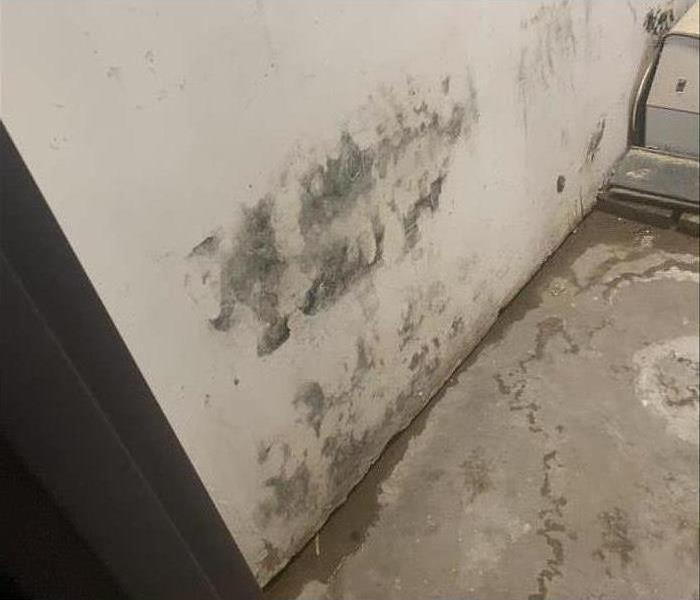 Water damage can lead to mold growth.
Water damage can lead to mold growth.
How to Minimize Flooding's Secondary Effects
Flooding from torrential rain or broken pipes can be overwhelming. Water damage can be expensive to repair, and floodwater may damage your personal belongings. Along with obvious problems like ruined sheetrock and flooring, flooding can also cause secondary damage in the form of black mold and mildew. High humidity and excess moisture can cause mold to grow and spread quickly in your Lake Point, TX home, so it is important to get it under control as quickly as possible by following four steps.
1. Assess the damage. Mold usually grows in hidden places, so you should not assume there is no fungus just because you cannot see it at first glance. It is important to investigate thoroughly to understand the extent of the problem if there is one. Mold frequently grows in the hidden places listed below:
- Inside wet walls
- Under damp carpet
- In porous items that have absorbed water
- Inside damp base cabinets
2. Remove damp materials. Because excess moisture encourages the growth of black mold, any wet materials need to be torn out of the home as part of the mold removal process. Porous personal items can be saved, but should be dry cleaned. Wet flooring and damp sheetrock need to be torn out and removed so the mold can be treated.
3. Dry the area. Once all wet materials have been removed, use fans and dehumidifiers to help dry the area. Opening windows to allow fresh air to circulate may also help dry out our home. Any trace of moisture should be gone to prevent mold from spreading before you can treat the existing fungus.
4. Use an antifungal treatment and disinfectant to remove mold. Spray an antifungal solution on existing mold and clean thoroughly with household cleaning products. While the first three steps limit the spread of mold, this one eliminates the fungus.
If not dealt with quickly and properly, black mold can spread quickly, posing serious to your home. High humidity can increase the growth of the fungus, leading to even more expensive secondary damage. Following the four steps above may help contain and eliminate the problem.
Making a Water Damage Insurance Claim: 3 Steps
12/30/2021 (Permalink)
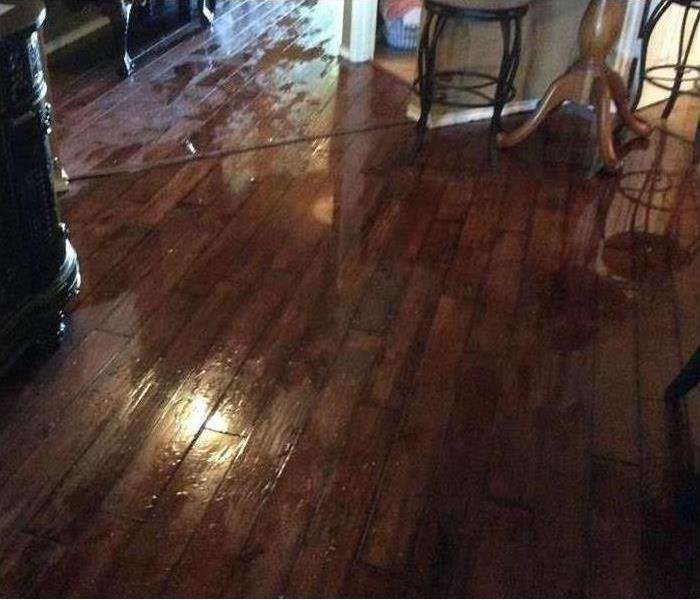 Water damage in Waterford Estates, TX.
Water damage in Waterford Estates, TX.
Making a Water Damage Insurance Claim: 3 Steps
When your Waterford Estates, TX, home is damaged by flooding, it can be difficult to know where to turn for help. Not only is there standing water to deal with as a result of burst pipes, but you might also be facing building material damage and mold growth, both of which can severely impact the integrity of the structure. Making a water damage insurance claim can begin the recovery process, and there are a few steps you can take to ensure the process goes smoothly.
1. Contact Your Local Agent
Once it becomes obvious that an indoor flood has caused a serious amount of trouble, it is wise to contact your local insurance agent to discuss your existing coverage and what other actions you need to take to file your claim. Your agent may be able to begin your claim over the phone and schedule an inspection so you can proceed with repairs without having to worry about the cost.
2. Take Photos
Taking photographic evidence of flooding caused by bursting pipes can help you provide proof of all the damage sustained to your insurance company. It may also offer proof that the flood was not due to neglected pipes or poor maintenance, which could cause a denial of coverage. Consider providing the insurance agent with photos and video so the evidence is well documented and print out photos to keep as part of your insurance records.
3. Review Repair Options
Once your claim is approved, you can move ahead with planning for repairs. Call in flood damage and restoration service to discuss which repairs are most needed, whether you can fix broken pipe components or if they need replacing, and whether you need mitigation for secondary damage, such as mold growth.
When bursting pipes or other water events cause a flood at your Waterford Estates, TX, home, the results can be devastating. Knowing how to file an insurance claim can provide you with peace of mind when the unexpected occurs.
What To Do if You Find Water in Your Light Fixtures
12/19/2021 (Permalink)
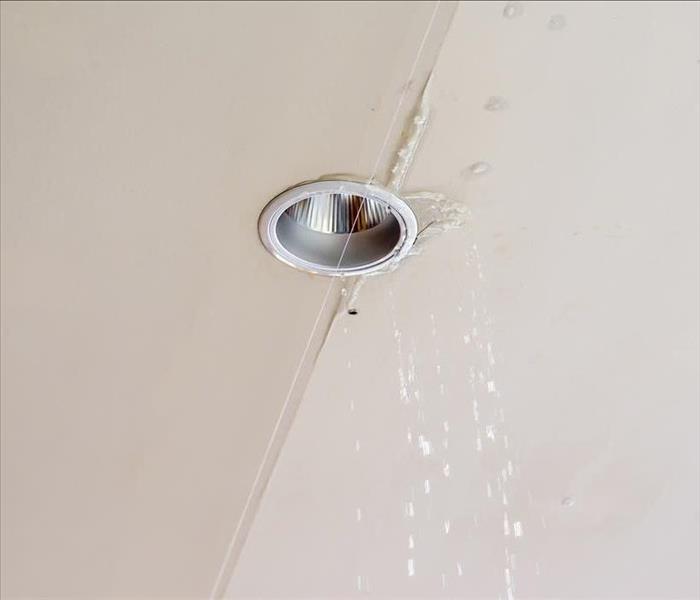 Water in light fixtures is a common way that homeowners realize there is a larger problem with their pipes.
Water in light fixtures is a common way that homeowners realize there is a larger problem with their pipes.
Safety Steps To Keep In Mind If You Find Water In Your Light Fixtures
It can be difficult to catch water leaks in your home in Lake Point, TX before they cause damage. Because pipes are hidden by the walls, you often won't know there is a problem until you see water in light fixtures or soaking through your ceiling. Because electricity and water don't mix, here are some important safety steps to keep in mind if you find water pooling in your lights.
1. Shut Off the Breaker
As soon as you notice water in your lights, don't touch them or the switch that controls them. Water conducts electricity very well, so it's easy for you to be shocked. Instead, go turn off the breaker for the room where the water is. If you see ceiling damage in other rooms, shut it off for those as well. To be entirely safe, it's a good idea to turn it off for the whole house, if possible.
2. Shut Off the Water
Once you shut off the electricity, it's time to stop the leak by turning off the water main. This may be an inconvenience, but it's better than having that water in light fixtures or coming through your ceiling.
3. Call the Professionals
You're going to need a plumber and an electrician to come in and fix both your leak and your light fixture. Depending on the amount of damage, you may also need to call a water damage remediation company after the electrician and plumber solve your immediate problems. Make sure you explain the whole situation to both of them, though, so that your electrician will know if he needs to wait for the plumber to finish before he can safely replace your light.
Water in light fixtures is a common way that homeowners realize there is a larger problem with their pipes. It can be dangerous if handled incorrectly, though, so make sure you follow these steps to keep yourself out of harm's way.
Three How-to Tips for Sewer Backup Emergencies
12/6/2021 (Permalink)
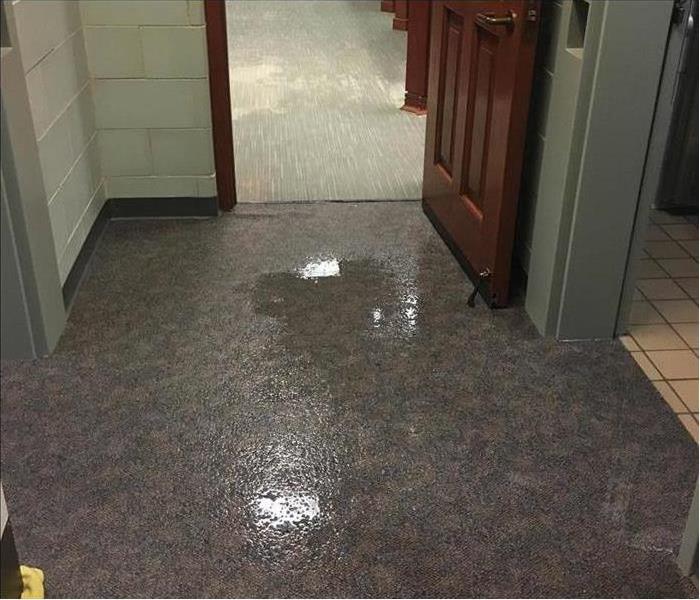 Removing standing water is important to avoid secondary damages.
Removing standing water is important to avoid secondary damages.
Tips for Sewer Backup Emergencies
Sewer damages present many unpleasant cleanup tasks. Before you pull out your shop vac and the kitty litter, however, there are several important considerations to keep in mind.
- Mistakes in the sewer cleanup process could affect the safety of the occupants in the building and the cleanup crews.
- Cleaning efforts must focus on both short-term and long-term recovery.
- Unaffected areas of the building must be protected from new contamination.
With these thoughts in mind, you're ready to begin the necessary cleaning steps.
One: Identify the Scope of the Damages
Whether you evacuate your home or not really has to do with the scope of the situation. If your home has been flooded because of a sewer backup, get everyone out until sewer recovery professionals tell you it's safe to return. If a flooded toilet is the main trouble, the rest of the family can probably go about their normal activities. Depending on the problem, you could shut off the water to the home or toilet.
Two: Schedule Necessary Professional Services
You may require a visit from your insurance adjuster. You might need a visit from a sewer cleanup professional in Towngate, TX. The sooner you can get professionals to inspect the flooding, the better. These resources can help you understand the best steps to take and how to fully recover. There are other benefits to hiring professionals for this cleanup.
- The insurance company may pay for the services.
- The scope of recovery may be more than you can handle.
- Sewage contamination that has been longer than 24 hours requires specialized treatments.
- At-risk family members are better off when expert services and techniques are used.
Three: Prepare for Cleanup You Do Yourself
Before you get into the water, prepare with rubber boots and gloves, eye protection, respirators, and coveralls appropriate for the water. Avoid direct contact with sewage materials, especially if you have open sources.
You don't need to be overwhelmed by sewer cleanup efforts. Remember to work closely with Towngate, TX, professionals.
3 Things To Know About Water Damage Cleanup
11/3/2021 (Permalink)
 It’s important to fix bursting pipes as soon as possible in order to prevent water damage.
It’s important to fix bursting pipes as soon as possible in order to prevent water damage.
There are a number of things that can lead to water damaging your property in Garland, TX. Whether you’re dealing with bursting pipes or storm-caused flooding, proper cleanup is important. Here are three important things you may want to know about taking care of the damage caused by water.
1. Where Water Damage Happens
Water from leaky pipes or storm flooding can damage your home in a variety of ways. The most common areas to look for moisture sources are your kitchen, bathroom, or laundry. These are the rooms where the majority of the plumbing is in your home. It’s also wise to check around your water heater. Flooding caused by storms can occur in the basement. It can also happen in attic areas if leaks have developed in the roof.
2. How Long Cleanup Should Take
In many cases, the amount of time it takes to clean and restore the areas damaged by bursting pipes may be concerning to you. The exact cleaning time can vary based on the type of damage, but, in many cases, a job requires three to five days. In the event of extreme damage or special restoration considerations, the process may last up to 10 days.
3. When To Call a Professional
The water damage in your home may be beyond what you can deal with by yourself. In those cases, it is always best to contact a professional for help. A cleanup service can assess your needs, fix a broken pipe and even take care of a full restoration if needed.
It’s important to fix bursting pipes as soon as possible in order to prevent water damage. Damage usually occurs in areas where plumbing is prominent, but it may happen in the basement or attic areas as well. Restoration can take about a week. Remember: When in doubt, it’s time to call a professional.
3 Steps To Replace a Toilet
3/8/2021 (Permalink)
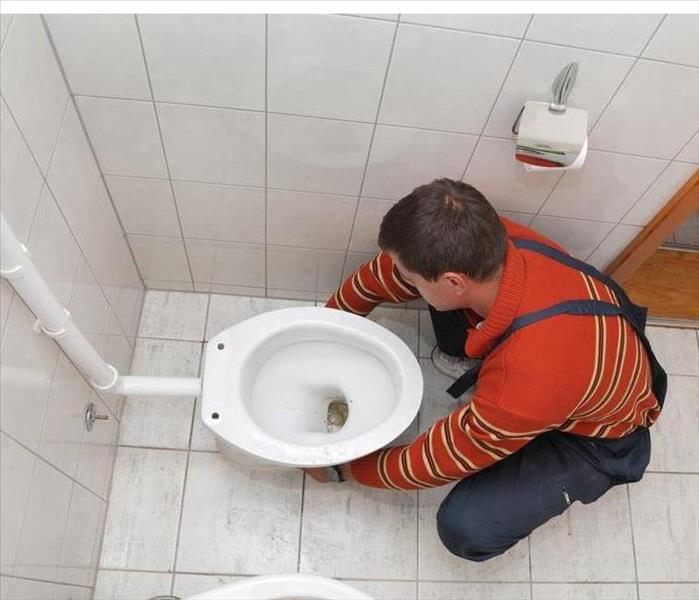 Toilet replacement in Lake Point, TX.
Toilet replacement in Lake Point, TX.
Here Are Three Steps To Replace A Toilet
Toilets are generally one of the most reliable plumbing fixtures. Unfortunately, there are times when homeowners may need to replace an old toilet. A leaking toilet is not a repair that many Lake Point, TX, homeowners are familiar with; however, it can be done on your own.
1. Tighten the Closet Bolts
If you’re lucky, the leak may be fixed by simply tightening the closet bolts. These bolts are located on the base of the toilet and affix the toilet to the floor. Grab a slotted screwdriver to pry off the caps that are covering the bolts. Once the caps are removed, use a wrench to gently and alternately tighten each bolt. If tightening the bolts doesn’t stop the leak, move to step two.
2. Remove the Toilet
There is a wax gasket located underneath the toilet that creates a watertight seal. If the leak isn’t fixed by tightening the bolts, the gasket needs to be replaced. First, turn off the water supply and drain all the water from the tank by holding the handle down. Next, disconnect the water-supply tube and use a wrench to loosen the bolts that hold the toilet onto the floor. Third, lift the leaking toilet off by the bowl, not the tank, and place it in the tub or on an old blanket. Scrape the old wax off the floor and center the new wax gasket down on the closet flange.
3. Replace the Toilet
Use the bolts on the floor as a guide to set the new toilet down over the wax gasket and closet flange. Place the washers over the bolts and thread on the nuts. Before tightening the nuts all the way, press down with all your weight to compress the gasket. Alternately tighten the nuts and keep pressing on the toilet to ensure a tight fit. Replace the caps and reconnect the water-supply tube.
Toilet repair can be an intimidating home repair project because a leaking toilet can cause major problems. If you experience any type of water damage, water damage repair specialists are available to help with cleanup.
Methods for Preventing Water Damage During Construction
2/10/2021 (Permalink)
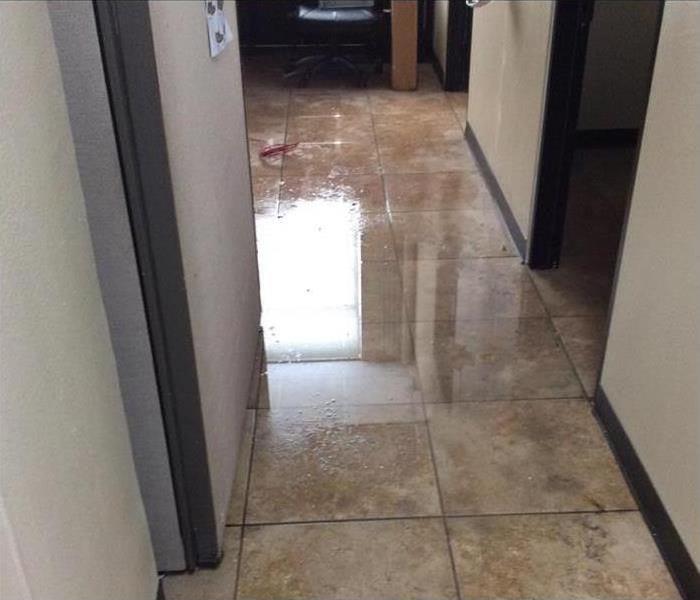 Commercial water damage
Commercial water damage
If you have to take a break from a construction project while you wait for a water pipe repair to finish and water remediation professionals to fix the damage, you can lose money and have unforeseen fees. One way to avoid this is to take proactive measures to prevent water damage from impeding your construction projects.
Have a Plan
Proper planning is the key to creating a watertight project. Here are some of the things you should consider in your water preparedness plan:
- Keeping electrical equipment away from water sources
- Using grading to divert water away from a project
- Installing windows and doors with minimal chance of intrusion
- Planning to create a waterproof building
Assign a Supervisor
To ensure the plan is properly carried out and you don't have to worry about water pipe repair jobs, you should assign a supervisor. This person will be responsible for ensuring that your water damage prevention techniques are implemented throughout the work.
Conduct Inspections
Your water preparedness plan should also assign someone to inspect the job site in Crystal Lakes, TX, each time it is shut down. The inspection should look for threats that could affect a building overnight or on weekends. If the inspector identifies any threats, such as a broken pipe, they will handle the situation before it leads to excessive damage.
Turn Off Water
Another way to prevent a water pipe repair is to turn off the water supply during off-hours. This means that when no one is working on the project, the water supplies should be turned off. However, this is only feasible if you don't have any machinery requiring a constant water supply.
To avoid the costly and time-consuming aspects of a flooded worksite, you should take proactive measures to prevent water damage. The techniques you use should range from proper planning to ensure the site is securely shutdown before leaving.
3 Rules of Thumb to Follow After a Basement Flood
12/30/2020 (Permalink)
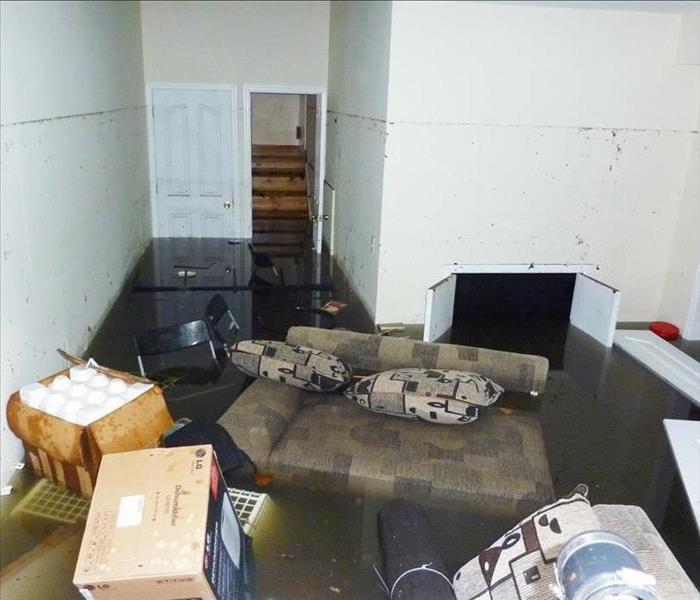 Flooded basement in Lake Point, TX
Flooded basement in Lake Point, TX
Three Rules To Proper Flood Clean- Up
After a basement flood in Lake Point, TX, many homeowners feel stuck. You may not know what to do next if you have never experienced a home flood before. Whether the flooding was caused by extreme weather or by a burst pipe, the following three rules should always be followed when it comes to proper flood clean-up.
1. Never Walk Into Standing Water
Following a significant flooding event in your basement, there may be an inch or more of water just sitting on the floor. While you may wish to walk into the space to examine the damage, it is never a good idea to step into standing water without taking the proper precautions. Before a thorough inspection is performed, there is always the risk of electrocution. Consider hiring a residential water restoration professional to inspect the basement for safety hazards. If you choose to walk through the floodwaters, always wear rubber waders to neutralize any electrical charges.
2. Don't Try to Save Appliances
As you sort through damaged materials after a flood, you may wish to save as many of your home goods as possible. It can be tempting to try to salvage electrical or gas appliances after a basement flood, but these fixtures are better suited for replacement. In some cases, your home insurance coverage may pay for the cost of replacement. Don't risk a mechanical or electrical malfunction; always throw-out these common pieces of equipment post-flood:
- Washers and dryers
- Ovens and ranges
- Dishwashers
- Electrical outlets
- Light switches
- Electrical wiring
3. Find and Fix the Cause
After the basement cleanup has begun, take the time to figure out what flooded your basement in the first place. There is nothing more frustrating than cleaning up and repairing a flooded basement, only to have the same issue occur again. A basement flood may feel like a nuisance, but safe and complete restoration can be achieved by following these three basic tips.
Important Information About Supply Lines in Your Home
12/30/2020 (Permalink)
 Copper piping is often used to repair a supply line leak because it does not affect the quality of the water
Copper piping is often used to repair a supply line leak because it does not affect the quality of the water
Important Information About Supply Lines in Your Home
Most people have a basic idea about how their plumbing system works in their home, but a few mysteries remain. A supply line for example is a term that sometimes causes a little confusion. In general, it refers to a pipe that transports water from one area to another. Most often it refers to the piping that goes from the main water line coming into the house to the various places that need water in your home in Towngate, TX. Therefore, a home is likely to have several of these lines. Supply line damage is therefore likely to involve clean water, and it could be a significant leak.
Pipe Materials for Supply Lines
An important consideration for supply line piping is that it must not contaminate the drinking water in any way. For this reason, copper piping is often used to repair a supply line leak because it does not affect the quality of the water. Other features of copper pipe include the following:
- Is somewhat difficult to install
- Tends to be very durable
- Found in older and newer homes
Another piping material, galvanized pipe, is no longer used in new plumbing systems. If supply line damage occurs to these pipes, plumbers will replace them with either copper, steel braided, or plastic lines.
Cleanup Options for Clean Water
Whenever water escapes into your home from a clean water bathroom leak or another source, it is important to act fast. Water on the floor can cause both primary damages of materials and secondary damage such as mold growth. A professional water restoration company will arrive quickly once it has been called. Technicians will work to stop the source of the leak and to remove any standing water from your home. They will use powerful fans to remove humidity which can cause the warping of floors, walls, and ceilings.
An awareness of the potential for supply line damage is important to protect your home. You should know the best methods of repair and cleanup.
4 Tips for Water Damage Prevention
12/9/2020 (Permalink)
 Water damaged ceiling
Water damaged ceiling
Here Are Four Tips For Preventing Water Damage
When it comes to the list of things you never want to deal with as an owner, finding water in your home is definitely near the top.
1. Inspect Pipes Regularly
It is easy to forget about pipes that are tucked away in the basement or crawl space. Because they are out of sight, a cracked or broken pipe here can go for a long time without being noticed. A tiny leak can lead to a lot of damage if left unchecked, so it is important to inspect your plumbing system every couple of weeks.
2. Check for Leaks
The next time you are grabbing something from under the bathroom sink, take a moment to look for standing water. Other common things to check are the area under your kitchen sink, any appliances that use water, the toilet and your water heater. Performing a visual check once a week can keep minimal any possible damage to your cabinets and floors due to water in your home.
3. Avoid Chemicals
The chemicals that are used to unclog drains are corrosive. Over time, they cause your pipes to weaken and can lead to cracking and bursting. Before you reach for the drain cleaner, try other methods of unclogging your pipes. For instance, you can use a wire hanger to fish some clogs from drains.
4. Call a Plumber
Leaking or flooding water is a problem that can lead to other issues. If you discover a plumbing problem, it is best to call a professional. Plumbers have the equipment to take care of pipe cleanup quickly, and if there is damage, they can point you in the direction of a reputable water damage repair expert.
Having to deal with water in your home in Club Creek, TX, becomes less of an issue if you take simple steps to prevent, recognize, and repair damage properly.
3 Water Issues Found in Commercial Buildings
8/17/2020 (Permalink)
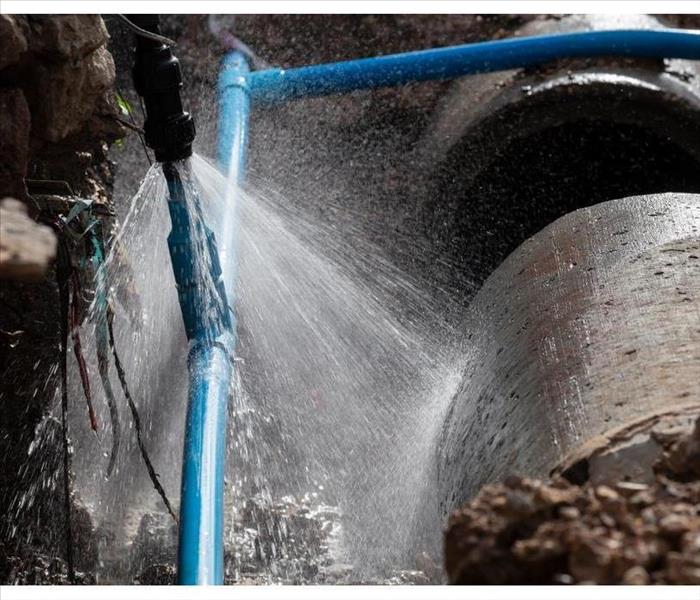 Broken water pipe in a Windsor Park, TX commercial building
Broken water pipe in a Windsor Park, TX commercial building
Three Common Water Issues In Commercial Buildings
Owning and maintaining a commercial property in Windsor Park, TX, can be profitable because it tends to offer a higher return on investment than residential properties. Properly caring for your commercial building should be a top priority. Various tasks include maintaining the exterior and interior of the building. Water damage caused by a variety of sources, such as leaking pipes, can be expensive to repair. Here are three common water issues in commercial buildings.
1. Damaged Water Pipes
A common water problem in commercial buildings is damaged or broken water pipes. While pipes are supposed to last for many years, the type of material, age, and lack of maintenance may result in a shorter lifespan. Some signs that you might have damaged pipes include bulging walls or the presence of water stains. If you have an obvious pipe break, major water damage can occur if immediate action isn’t taken. Contact a commercial restoration specialist right away to help minimize harm and financial loss.
2. Water Leaks
Due to the large size of commercial buildings, water leaks often go unnoticed until they become a major problem. Water leaks can happen from a water heater, on your ceiling, around toilets, and from leaking pipes under sinks. Pinhole-sized leaks are the enemy of most property owners due to their discreet nature. Fortunately, you can prevent most water leaks by keeping a close eye on your commercial property. A few preventative measures include having the roof regularly inspected, checking under sinks, and installing smart water sensors.
3. Deteriorated Sewer Lines
While sewer lines are designed to last for over twenty years, there are some circumstances that lead to early deterioration and damage. Sewer gas odors, frequent toilet backup, and clogging of drains compromise the quality of sewer lines.
Appropriately maintaining your commercial property is important to your financial investment. Identify common water issues, such as leaking pipes, and take steps to prevent them from occurring.
Leaks Happen
9/4/2019 (Permalink)
You know the normal sound your home makes and when something is different you will know, if you hear it.
The air conditioner kicking on as the dog days of summer begin. The heating system starting up on a cold, winter’s evening. The creak of a loose floorboard as someone rises early in the morning.
What you don't normally hear - and you do not want to hear- are the sounds of spraying water from a broken pipe or a malfunctioning hot water tank or water filter system. Even worse is when this happens when you aren't home and upon arrival you wade through inches of water on the floor, or have water pouring on your head from the dripping water from an upstairs leak.
Statistics say water damage claims are among the highest with insurance companies. You need to act quickly. #1 concern is to think safety first.
Next, find the water turn-off valve and stop the flooding. Many homeowners aren't sure where the water turn-off valve is located. Now is the time to figure that out, and even put a tag on it so it is easy to find, especially in the dark or in the beam of a flashlight. Do not delay...find that valve and mark it!
It's always best to be prepared. Contact SERVPRO of South Garland and get the info you need to be safe...just in case.
Call SERVPRO of South Garland (972) 278-7871
Moisture in Walls Can Lead To Mold Damage in South Garland
9/3/2019 (Permalink)
Mold Damage South Garland
Even small water damages have the potential to cause serious structural and indoor air quality issues over time. The key to avoiding costly problems in the future is to handle water damage as a threat to your property. SERVPRO of South Garland has the equipment and training and experience to find and dry unseen water before secondary damages occur. The proper equipment makes a measurable difference in reducing the damage expense during a fire or water loss. When time matters, technology, and equipment must be counted on to perform. SERVPRO of South Garland will answer your call with rapid action and a full arsenal of drying equipment. Here are a few of the tools used by SERVPRO of South Garland:
Moisture Sensors are used to detect moisture in carpets, baseboards, and walls
Moisture meters are used to determine the actual moisture content of various materials. The moisture tester provides accurate tester provides accurate readings, allowing SERVPRO of South Garland to monitor the drying process.
Thermo hygrometers measure temperature and relative humidity. When armed with this information, SERVPRO of South Garland can calculate and create an environment most conducive to drying. When facing a contaminated water loss, it is not only important to dry the structure, but the structure must also be disinfected and often deodorized.
Ultra-Low-Volume Foggers will atomize liquid deodorizing agents, producing a fine mist that can easily penetrate the site where odor-causing residues may accumulate.
This device can also be used to inject fungicides and disinfectants into wall cavities and other hard-to-reach areas.
Thermal Foggers dispense solvent-based products by creating a dense fog, consisting of tiny particles of deodorant solution that attach to and neutralize odor-causing particles to destroy the odors.
Call SERVPRO of South Garland at (972) 278-7871
IICRC and SERVPRO
4/11/2019 (Permalink)
SERVPRO of South Garland is certified by the Institute of Inspection, Cleaning and Restoration Certification (IIRC) is an international non-profit organization for the standardization and certification of the inspection, cleaning and restoration industries worldwide.
They are unmatched in technical excellence, the IICRC Standards are developed to provide the highest quality concepts, terminology, and procedures recognized in the cleaning and restoration industry.
SERVPRO of South Garland is a Certified Firm with the IICRC. Our technicians are also certified technician with annual training to keep up with the changing technologies. We want to take care of your home or business.
We can handle all of the water in your home, starting with the removal of standing water with our pump trucks, and then followed by our specialized equipment. Some equipment is designed to raise the temperature of your home's structure, while at the same time creating a high air flow that will whisk the humidity created to the outside. With the water disposed of after removal by the pump truck, our team will begin restoring your home's interior.
In addition to drying and restoring your home, we will also clean and sanitize everything. Risks from floods are all too real, and can pose threats to safety for months after a flood has receded. Other equipment is used to extract water and moisture from upholstered furniture, wooden structures, and walls. We will use dehumidifiers to increase the speed of the drying process, and as we do this, we will monitor the moisture levels in various areas of your home. This monitoring can be used as documentation to show insurance companies the work done, and also to future prospective home buyers who are interested in purchasing your home.
Whenever you're in need of water removal, large or small, call us! SERVPRO of South Garland can be reached at (972) 278-7871, 24/7, and we will respond as soon as possible to begin working on getting your home returned to its intended state.
Remodeling Misstep Means Water Damage Issues in Garland
3/15/2019 (Permalink)
SERVPRO Steps In to Mitigate Damage Caused by Leaks
Sometimes even experienced plumbers make mistakes that result in water damage in unexpected places. A bathroom update that results in leaking or poor drainage requires another look at the plumbing renovation and restoration of damage done to your home’s structures. SERVPRO of South Garland technicians receive training to detect where the water intrudes as well as how to return your home to preloss condition.
Water damage after a remodeling of your Garland bathroom is a frustrating outcome. A decision to use a diverter spout to add a handheld shower in your classic tiled bath area causes a blowback issue resulting in water spraying inside your wall as well as through the shower head. Even a small amount of blowback results in significant harm over time. Our technicians help pinpoint the problem and develop a plan to restore the damage.
A desire to retain the character of the original bathroom drives the decision to add to existing plumbing rather than tear out and replace. Unfortunately, the older pipes need help to connect with modern fixtures. If the connections added, fail to seal and balance water pressure correctly, leakage occurs. SERVPRO of South Garland locates the problem and takes steps to dry out the saturated areas. Often an older bathroom has a large access panel in an adjacent room, closet or hallway we open to find the leak and then keep open to direct air flow that removes the moisture.
We work with plumbing contractors to resolve the blowback problem as we dry out the area behind the bathtub and shower. We also follow the path of the water to discover any migrating moisture causing damage to the walls or ceilings below. Older homes often have plaster construction which sheds water more easily than drywall. SERVPRO of South Garland water damage technicians still develop drying goals to ensure any lathes behind the plaster avoid secondary damage like mold growth or disintegration.
Air movers, augmented with dehumidifiers, do a thorough job of removing the moisture once the spout is re-installed with proper taping, caulking or other safeguards preventing further water damage. Bubbled paint or staining restore to the pre-leak condition when touched-up after drying is complete.
Do not despair if a remodeling project takes an unexpected turn. SERVPRO of South Garland has the staff, experience, and equipment to get things back on track. Call for an appointment at (972) 278-7871.
Info on South Garland is right here.
Water Heater Water Damage in Garland from a Leaky
3/15/2019 (Permalink)
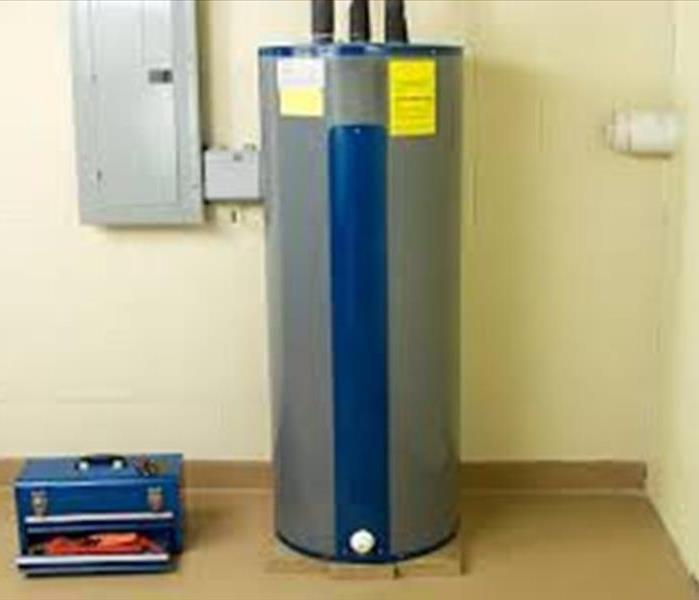 Water Damage from Water Heaters Gets Mitigated Quickly with Our Help
Water Damage from Water Heaters Gets Mitigated Quickly with Our Help
SERVPRO TIP: Inspect Your Water Heater Periodically to Avert Water Damage
Have you checked your Garland water heater lately for signs of suspicious moisture? It can take the form of excess condensation on the heater’s surface or drops of water on the floor around it or in the catch pan. The team at SERVPRO of South Garland is often called in to deal with a flooded basement caused by a worn out water heater.
The useful life of a water heater is about 8 to 12 years, according to experts. At that point, tiny cracks develop, metal deteriorates, and rust forms. A wise homeowner regularly inspects the heater for signs of wear and the basement for evidence of water damage in Garland.
Standing water is a sure sign of a problem. But you can catch a leak in its early stages by checking for less obvious indicators, including:
Moldy, musty smells along the walls or coming from boxes stored on the floor
Telltale stains on floors, walls, and ceilings, including rust
Warped, lifted floor tiles
Peeling paint
Excess condensation on the water heater
If you see any of these danger signs, call SERVPRO of South Garland. We have the expertise and the equipment to remove the water, dry and dehumidify your rooms, and then clean, repair and restore them to make them livable again. We start with a comprehensive inspection and assessment of your basement.
Water damage can be so pervasive; it takes professional equipment to get your home dry. Our industrial strength pumps extract the standing water quickly. By removing as much water as possible, we speed up the drying time significantly.
After extraction, we deal with the moisture in the air. Powerful air movers blow damp air out. These are used in conjunction with dehumidifiers that remove water vapor and reduce humidity. Once the basement is dry enough, we clean up the damage, restore wherever possible, and replace when necessary. The result looks “Like it never even happened.”
SERVPRO of South Garland is here to help with your water damage problems and other water, fire and mold emergencies. Call us 24/7 at (972) 278-7871. We are centrally located, serving Garland, South Garland, Towngate, Duck Creek and other local areas.
Understanding Water Damage in Garland, Texas
3/12/2019 (Permalink)
Understanding Water Damage in Garland, Texas
When your home or business suffers water damage in Garland, TX, understanding what type of water you are dealing with is critical to ensuring proper cleanup.
There are three types of water.
Clean water is water from a broken pipe or other water source; rainwater is also considered clean.
The term gray water is used to classify slightly contaminated water. Clean water becomes gray water when it is left untreated allowing bacteria and other contaminants to begin growing, making the water hazardous.
Black water is highly contaminated and filled with fungi, bacteria, chemicals and more. Black water is typically caused by sewage damage, flooding or any type of natural disaster. Black water should always be handled by trained professionals.
Consider taking the follow precautions to help minimize damage or prevent further damage while waiting for help to arrive.
Damage from Clean Water in Garland, TX
-Shut off water source if possible or contact a qualified professional to do so.
-Turn off circuit breakers for wet areas of the building if access to the power distribution panel is safe from potential electrical shock. Do not enter rooms with standing water, as electrical shock hazards may exist.
-Remove as much excess water as possible my mopping and blotting. Wipe excess water from wood furniture after removing lamps and table items.
-Remove and prop up wet upholstery cushions to allow more even drying.
- Move any paintings; art objects computers, documents and other valuable items that may be sensitive to moisture to a safe place.
-Do not leave books, newspapers magazines or other colored items on wet carpets or floors as they may cause staining.
- Do not use your household vacuum cleaner to remove water as there is potential for electrical shock causing damage to the vacuum cleaner.
-Do not turn on ceiling fixtures if the ceiling is wet; do not enter rooms where ceilings are sagging from retained water.
Damage from Contaminated Water in Garland, TX
-Avoid all contact with sewage and items contaminated by sewage. Wash your hands thoroughly if you come in contact with contaminated items.
-Do not walk through contaminated areas, as you could spread damage to unaffected areas.
-Do not turn on the HVAC system if there is a possibility of spreading contaminated air.
-Do not use household fans to dry the structure; air flow could spread contaminants.
-Discard any food and/or products for personal hygiene and cleanliness if exposed to the contaminated areas.
Call SERVPRO of South Garland at 972-278-7871
What are the Hazards of Water Heater Overflows?
9/4/2018 (Permalink)
What are the Hazards of Water Heater Overflows?
With the added elements of high temperature and late detection, the number of threats with water heater flooding exceeds that of normal flooding. Here are some things to look out for in the event of a water heater overflow:
- Hot water burns– The initial burst of water from a heater is scalding hot, so be sure not to rush in, especially if you see steam. Use protective clothing before attempting anything. Ideally, call SERVPRO of South Garland to do the job for you. (972) 278-7871
- Electrocution by water– A flooded basement carries the risk of having the water making contact with power outlets and exposed wiring. When this happens, the floodwater carries a strong electric current that’s enough to kill anyone. When you see your basement flooded, resist the impulse to dive into the water in an attempt to shut the leaking heater down. Contact SERVPRO of South Garland for help. Our professionals will be able to determine whether there’s an electrical threat or not. They’ll know the safest procedure for shutting down the water source and containing and extracting the water from your property.
- Potential fire starter– Flooding doesn’t just create an electrical hazard, it can also short-circuit your electrical system and create sparks. Faulty electrical wiring is one of the most common causes of fire.
- Water damage– When the water spills beyond the immediate surroundings of the heater and gets into your living and work spaces, the threat of water damage arises. Water can ruin carpets, damage wood, corrode metals and toast expensive appliances and machinery.
- Mold growth– Mold spores can activate in places where there’s sufficient moisture and organic matter to sustain them. If your property was flooded by an overflowing heater, there’s a good chance that mold growth can follow suit. While seemingly harmless at first glance, mold can irritate our noses and skin when its spores are inhaled. But mold does not have to even get a chance to grow, SERVPRO of South Garland can stop it in its tracks.
Contact SERVPRO of South Garland now at (972) 278-7871
A water heater overflow is an emergency that should be addressed rapidly and decisively. The longer you wait the worse it can get and attempting to repair the water heater and clean up the water yourself could be dangerous and risky. Contact an experienced professional through SERVPRO of South Garland today for a quick and easy resolution to your problem. "We're Always Here to Help" 24 hours a day, seven days a week, all year long.
Leaking Appliances
9/4/2018 (Permalink)
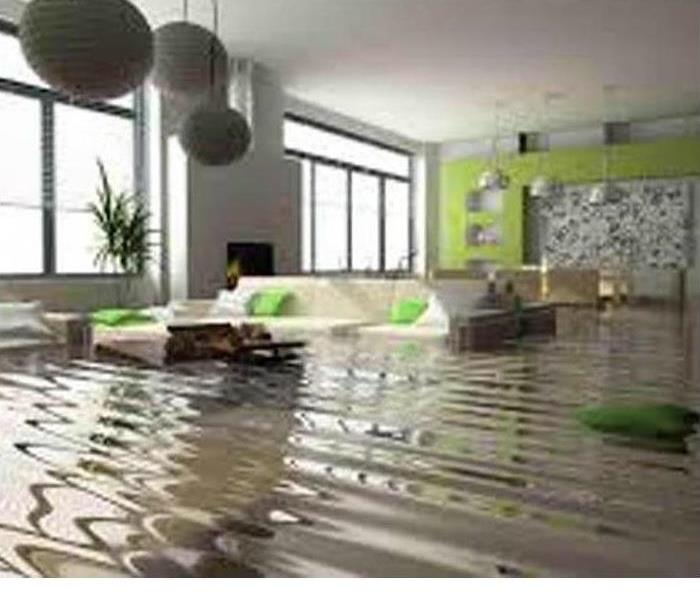 Call us with any issues you have had from leaking appliances!
Call us with any issues you have had from leaking appliances!
Most household floods and water damage are caused by plumbing or appliance failure, according to a study by a U.S. plumbing and drain service company.
The bill for these disasters can add up to hundreds or even thousands of dollars.
This study shows that only about 8 percent of residential flooding claims are the result of weather. Thirty percent are caused by appliance failure like a dishwasher leak and 62 percent by plumbing failure a hose or pipe bursting.
So, in short, the majority of water losses are preventable.
Fortunately, there are some easy steps homeowners can take to protect their homes - and wallets -- from water damage.
- Dishwasher
Dishwasher lines and hoses can spring a leak or blow out, often in the middle of the wash cycle, and flood your kitchen with gallons and gallons of water.
Prevent the problem: Never run the appliances if you're not going to be home, If a pipe bursts, you can minimize the damage by shutting off the water at the water supply line under the sink.
Prevention is key.
Rubber hoses commonly are used to supply water to a dishwasher, and they deteriorate over time. Replace the rubber hose with a much sturdier steel-braided hose found at most home improvement centers and hardware stores). Buying the hose and installing it yourself costs about $20.
- Washing machine
Malfunctioning dishwasher drains or water hoses result in some of the most common claims filed by homeowners, says Douglas Nadeau, a spokesman for State Farm. "Most homeowners leave washing machine water supply lines turned on so when a hose busts, water can discharge at up to 500 gallons per hour, causing major damage in a short period of time." Nadeau says.
Prevent the problem: Joseph King, a spokesman for the Insurance Institute for Business & Home Safety, suggests inspecting washing machine hoses often. "If they're original equipment and more than 5 years old, replace them with stronger steel-braided hoses," King says. These can be installed by a homeowner with a little guidance from a plumbing specialist at a home improvement or hardware store.
For added peace of mind, King suggests installing an automatic shut-off valve equipped with an alarm to alert you of any hose problems. This kind of valve costs about $100 but can save thousands of dollars if it detects a leak and prevents flooding.
- Leaky toilet
Any kinds of toilet leaks are signs of trouble. Cracks to the tank or toilet aren't common unless something hits the tank, such as a picture falling off the wall and hitting the "throne."
"More often than not, the supply line to the water tank develops a hole," Lazarus says.
Prevent the problem: it's better to replace a leaky toilet than to repair it. A new tank and bowl can run anywhere from $89 to $250 at a home improvement or hardware retailer. "If you hire a plumber to install the new tank or toilet, it may cost about $150 or more.
If the water supply line is the problem that's easy to repair. "Replace it with a metal-braided supply line because they tend to hold up better in the long run," he says.
Remember if all else fails call SERVPRO of South Garland (972)278-7871
The IIC.... what?
4/13/2018 (Permalink)
SERVPRO of South Garland is a fully certified restoration company. But who does the certification? Upholding a high standard in this business is an important aspect that we do not take lightly, and the Institute of Inspection, Cleaning and Restoration Certification is there to help us every step of the way.
So what is the IICRC? They say it best:
"The Institute of Inspection, Cleaning and Restoration Certification (IIRC) is an international non-profit organization for the standardization and certification of the inspection, cleaning and restoration industries worldwide.
The IIRC is considered a Standards Developing Organization (SDO), which means that they are responsible for developing and setting the standards of operation within these particular industries. The IIRC is a member of the American National Standards Institute (ANSI), which is an organization that oversees the development of national standards, requirements for due process and other elements of approval set by the standard developer."
In short, they ensure, along with SERVPRO of South Garland, that all of our work we can do for any water loss you may have, is verifiable up to the highest standards possible.
Prevent Water Loss In Your Home
3/15/2018 (Permalink)
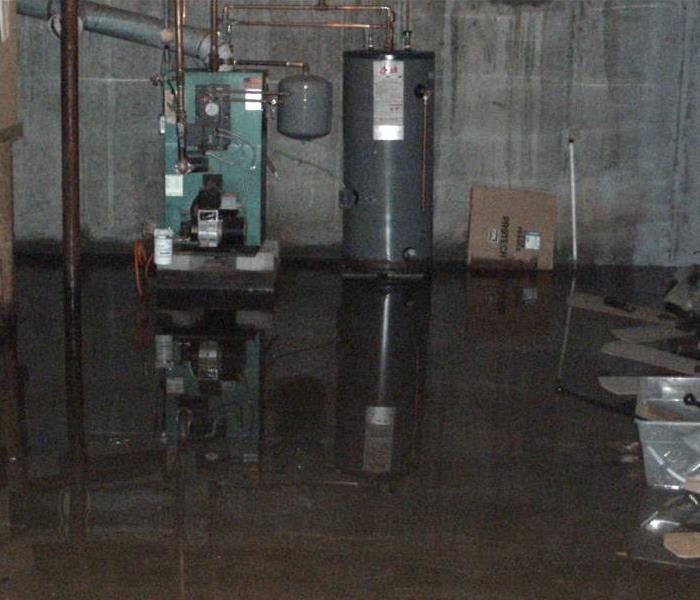 Water Heater Go out over time. Make sure to flush yours every year.
Water Heater Go out over time. Make sure to flush yours every year.
Learn how to prevent household water loss with these tips!
Water is a precious resource. It’s important to conserve water. Not only does saving water help save more water for drinking and agriculture, but it also helps to keep your water bill low. In turn, it helps you to save money. However, sometimes you’re unaware of the fact that you’re using water. Sometimes you’re a victim of water loss. Check out these ways that you can help prevent water loss in your home.
Inspect Home Appliances.
Appliances like your air conditioner, washer, and refrigerator all require water usage. However, it’s important to inspect your appliances regularly to ensure they’re working properly. A worn or broken hose can quickly turn into a disaster. Avoid any unnecessary water loss and replace your appliance hoses when needed. Additionally, pay attention to your ice maker. The hose that connects to your water line often times can lead to water loss.
Be Vigilant of Your Home’s Plumbing.
A plumbing leak can wind up causing serious damage to your home. Plus, it can cause your water bill to skyrocket. Check your home periodically for any signs of leaks. If you notice any water stains, rusty water, loud noises coming from your pipes, or spikes in your water bill, have a professional come to inspect your home’s plumbing. You likely have a leak that’s causing serious water loss.
When it comes to your home, ensure that you do your part to prevent water loss. You’ll save money and help in water conservation efforts, and you’ll contribute to reducing your risk for household water damage. Knowing who to call in an emergency situation can be crucial to keeping your items from further damage. SERVPRO of South Garland is your one stop to stop the water damage in your home or business.
Remember to watch your Apliances
3/15/2018 (Permalink)
 The supply line is the easiest to replace. Check at least once a year for damage. like rust, or cracking in the pipe
The supply line is the easiest to replace. Check at least once a year for damage. like rust, or cracking in the pipe
Most household floods and water damage are caused by plumbing or appliance failure, according to a study by a U.S. plumbing and drain service company.
The bill for these disasters can add up to hundreds or even thousands of dollars.
This study shows that only about 8 percent of residential flooding claims are the result of weather. Thirty percent are caused by appliance failure like a dishwasher leak and 62 percent by plumbing failure a hose or pipe bursting.
So, in short, the majority of water losses are preventable.
Fortunately, there are some easy steps homeowners can take to protect their homes - and wallets -- from water damage.
- Dishwasher
Dishwasher lines and hoses can spring a leak or blow out, often in the middle of the wash cycle, and flood your kitchen with gallons and gallons of water.
Prevent the problem: Never run the appliances if you're not going to be home, If a pipe bursts, you can minimize the damage by shutting off the water at the water supply line under the sink.
Prevention is key.
Rubber hoses commonly are used to supply water to a dishwasher, and they deteriorate over time. Replace the rubber hose with a much sturdier steel-braided hose found at most home improvement centers and hardware stores). Buying the hose and installing it yourself costs about $20.
- Washing machine
Malfunctioning dishwasher drains or water hoses result in some of the most common claims filed by homeowners, says Douglas Nadeau, a spokesman for State Farm. "Most homeowners leave washing machine water supply lines turned on so when a hose busts, water can discharge at up to 500 gallons per hour, causing major damage in a short period of time." Nadeau says.
Prevent the problem: Joseph King, a spokesman for the Insurance Institute for Business & Home Safety, suggests inspecting washing machine hoses often. "If they're original equipment and more than 5 years old, replace them with stronger steel-braided hoses," King says. These can be installed by a homeowner with a little guidance from a plumbing specialist at a home improvement or hardware store.
For added peace of mind, King suggests installing an automatic shut-off valve equipped with an alarm to alert you of any hose problems. This kind of valve costs about $100 but can save thousands of dollars if it detects a leak and prevents flooding.
- Leaky toilet
Any kinds of toilet leaks are signs of trouble. Cracks to the tank or toilet aren't common unless something hits the tank, such as a picture falling off the wall and hitting the "throne."
"More often than not, the supply line to the water tank develops a hole," Lazarus says.
Prevent the problem: it's better to replace a leaky toilet than to repair it. A new tank and bowl can run anywhere from $89 to $250 at a home improvement or hardware retailer. "If you hire a plumber to install the new tank or toilet, it may cost about $150 or more.
If the water supply line is the problem that's easy to repair. "Replace it with a metal-braided supply line because they tend to hold up better in the long run,
GET THE WATER OUT NOW!!
9/5/2017 (Permalink)
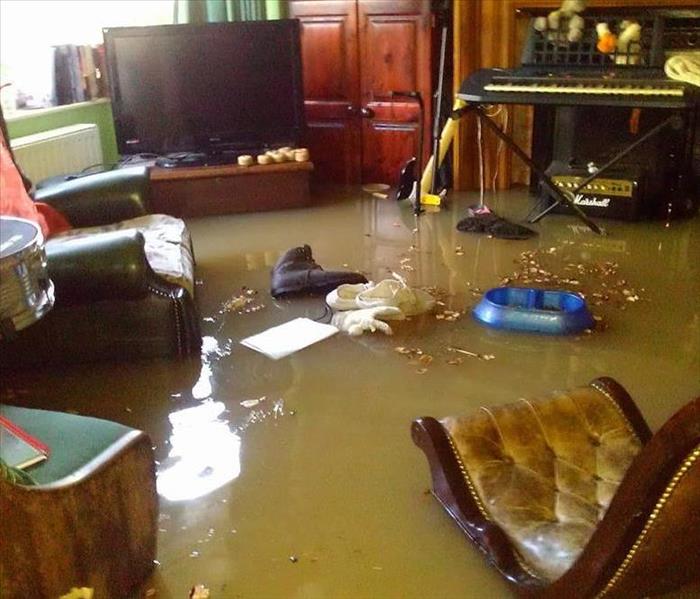 Call SERVPRO South Garland today at (972)278-7871
Call SERVPRO South Garland today at (972)278-7871
SERVPRO' s Expertise Saves Homeowners Money and headaches with quick and efficient Water Extraction.
Rapidly removing water reduces the damage that water does to your possessions.
Burst Pipes, broken valve, leaking drain, busted water heater, or a leaking roof can lead to significant water damage in your homes.
Here in Texas the severe weather is always a threat, tornadoes, Hail, or flooding, can devastate entire neighborhoods in our area. And it seems just when you start to dry out another round of storms is on its way. Water damage from weather, broken plumbing, or improper drainage can be a significant blow to a homeowner.
At SERVPRO we know how important it is to you to be back in your home as quickly as possible, to eliminate the risk of more damage we need to get the water out of you home as quickly as possible, depending on the amount of space in your home that was flooded and the amount of water released into your home this process can take a few days to a week or more, our team of technicians are IICRC certified in water removal mitigation and works fervently to make sure the process is as painless and efficient as possible for you
Each locally owned office maintains a 24-hour response team specializing in water removal. Damage with standing water in the home starts immediately and any standing water needs to be removed as soon as possible. SERVPRO owns and keeps on hand a variety of pumps and water extractors that are designed for residential homes and commercial buildings, each office maintains generators to support the teams and equipment because what is the point of having equipment if the power grid is knocked out from the storm and not having a way to have power in the storm.
After the standing water has been removed our technicians apply and anti-microbial solution, and utilize a series of fans and dehumidifiers based of the size of each affected room and the amount of open air in the house. This is to remove the excess moisture in the affected materials and remove the humidity to prevent any anti-microbial growth (these can range from just bad smells to mold or even the decomposition of materials). The technicians also may use specialized mat systems for wood floors, and set pads under furniture to minimize staining of the carpet and to protect the furniture. Ink may bleed and run from cloth or paper good and most of the time this makes them almost impossible to salvage, but our highly trained technicians may be able to if they get to them quickly enough.
If you are concerned about preventing damage, you can contact us for an inspection or if you have need of our services now, call us at (972) 278-7871. As a locally owned business, SERVPRO of South Garland is dedicated to restoring the homes of our neighbors.
Water Heater Overflow Cleanup
8/25/2017 (Permalink)
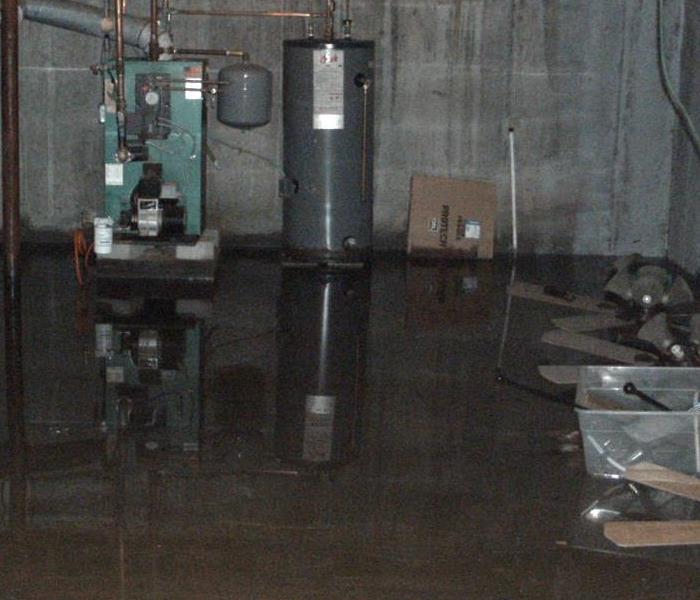 call SERVPRO of South Garland at 972-278-7871
call SERVPRO of South Garland at 972-278-7871
Water Heater Overflow Cleanup
One of the most prevalent causes of indoor flooding is water heater overflows. These water heaters are usually located in basements, attics, garages, or a utility room closet; places people don't go very often. So, if a burst or leak happens, the homeowner or tenant likely would not find the problem until after a significant water intrusion has already occurred. If this were to happen to you, you'll want to stay calm, shut off the heater and water, and contact the SERVPRO of South Garland professionals for help.
SERVPRO of South Garland has the professionals who are equipped to handle a water heater overflow. They have the knowledge, tools, and experience to deal with the situation safely and effectively whether it's your home or workplace that is in jeopardy.
How Do Water Heater Overflows Happen?
Water heater related floods usually occur due to a worn out seal or gasket, or from a leak in an older tank that rusted through. Sometimes a tank can actually explode or burst in a violent and dangerous manner. This could cause serious harm to anyone who is in the immediate vicinity of the water heater at the time of the explosion. Leaks are more common than bursts and have the potential to flood large portions of a home or basement if the leaking is undetected for days on end.
A malfunctioning thermostat is usually the cause of a water heater burst. These thermostats are used to measure the temperature inside the tank to turn the heating elements off and on so that a preset desired temperature range can be maintained. In the event of a broken thermostat, the heating system inside the tank could stay on indefinitely and cause the water to boil. This boiling water turns into steam and builds up internal pressure inside the tank. This internal pressure will build up and eventually reach a point where the tank cannot hold it, which will result in a burst or even explosion.
When such a burst occurs, steam and boiling water rush out of the tank, while cold water from the intake line flows into the tank. Normally, the line will shut itself off, preventing water entry when the tank if full. However, in this situation, the burst tank is never full because of the continual leaking, and the water from the main line flows through indefinitely. Water is entering the tank only to leak back out and flood the area around and below the water heater. The only upside to this scenario is that someone will likely hear the loud burst and investigate and discover the problem before too much damage has occurred and remediation can be started.
A leak, on the other hand, operates quietly and floods your home, basement, or workplace a little at a time. Usually, it will happen when one of your heating tank's fittings becomes damaged or corroded. This can provide a gap that allows water to escape. This flooding is not violent like a burst or explosion, but it can still be extremely destructive to property and sometimes dangerous to humans or pets. Regular maintenance and inspections of your water heater will increase awareness of possible problems. A professional can replace the anode, flush the corrosion from your tank, as well as check all valves and gaskets for problems or warning signs.
If your water heater is leaking call SERVPRO of South Garland at 972-278-7871 we will be there and be ready to help.
Tips to Follow: Cleaning Your Home After Water Loss
3/20/2017 (Permalink)
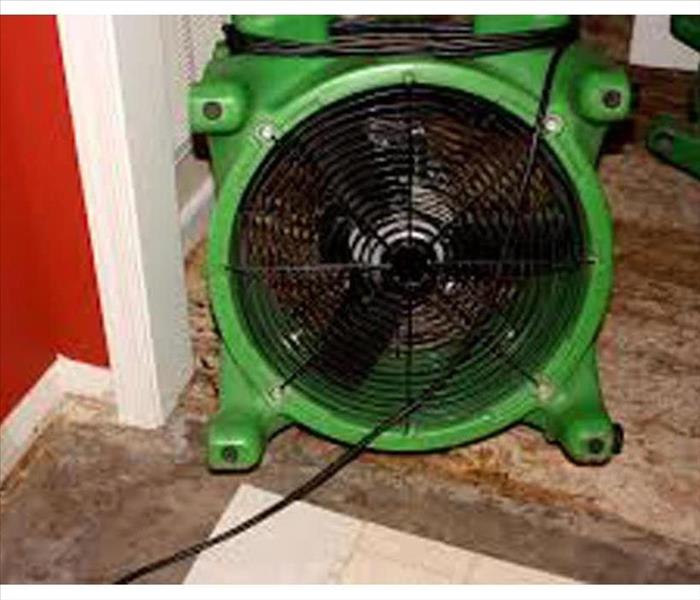 Don't let water sit and damage your home and belongings call SERVPRO of South Garland at (972)278-7871 right away.
Don't let water sit and damage your home and belongings call SERVPRO of South Garland at (972)278-7871 right away.
Cleaning Your Home After Water Damage: Tips to Follow
There can be a lot of damage caused by water in unwanted places in your home. Not only can your house be ruined but also the prized possessions it stores. You can possibly save some of your possessions and minimize damage. Your success will be determined by how long the water has been around. If the water reached electronics, there may be little hope for saving these.
However, carpets and even pieces of furniture might be saved. It is not a good idea to treat this lightly. Even an inch of water in the basement will breed mold. The growth of mold can ruin flooring, carpets, furniture and even walls. This could lead to poor quality of indoor air. Here are a few tips to cleaning your home after water damage.
Dry Your Home
The first tip you need to follow in cleaning your home after water damage is to dry out the area affected. Mop up all the water, use a dehumidifier and fans to help you in drying out the area. Open windows to circulate the air if the weather permits. Finish the basement and the drywall first. Check to see what floors have water in them and mop each one. If the water has risen higher than just a couple of inches, use buckets and old towels to manually get rid of the water. Pour water out on the lawn. If water is in carpets you may need to lift the carpets and remove the pad underneath as it will hold a lot of water. Use a wet vacuum cleaner if the plug on the wall is dry and up high. Remember that electricity and water are a bad combination and can be very risky. For this reason, it is recommended that you use the manual bucket method. Professional water damage remediation is needed in this area if you don’t have time and don’t want to make the effort to dry your home yourself. You can give SERVPRO of South Garland a call at (972)278-7871.
Unplug Electronics
When cleaning your home after water damage, remove furniture and electronics as soon as you can. Unplug electronics and disconnect the power. You may be able to save items that you remove quickly. Turn off the power that leads to areas affected, particularly if the water has risen above the height of electrical outlets. Pull out any under-padding and wall to wall area rugs. Get these disinfected and cleaned by brushing them with mild detergent and laying them out in the sun. If the weather does not permit, you will need to get these professionally cleaned.
Prevent the Growth of Mold
Dry out the entire area affected by the flood. Materials such as drywall and wood subfloor can still be moist enough to promote mold growth while seeming dry to the touch. Because if this you should always use a moisture meter to determine if a material is dry. You can then prevent mold growth by applying a mold growth controller on the floor, walls and furniture. Let this dry overnight. Spray the entire room and you can even use a spray bottle or a mister to do this.
Disinfect Your Home
Dry out the drywall, insulation and wooden beams. The next step is to get disinfect the entire area. The reason for this is because bacteria may have seeped through the sewers and toilets and on the water that filled your home. Use a powerful but non-toxic disinfectant. Every area that the flood water affected including non-upholstered furniture and wood furniture that was on the floor needs to be disinfected.
Restoring your home to its pre-water damage condition can be quite time consuming, and will require much effort from the family or the homeowners. Instead of doing this on your own, you can always hire professional water damage remediation service providers like SREVPRO of South Garland (972)278-7871 we are always ready to help.
Learn How to Prevent Household Water Loss
3/15/2017 (Permalink)
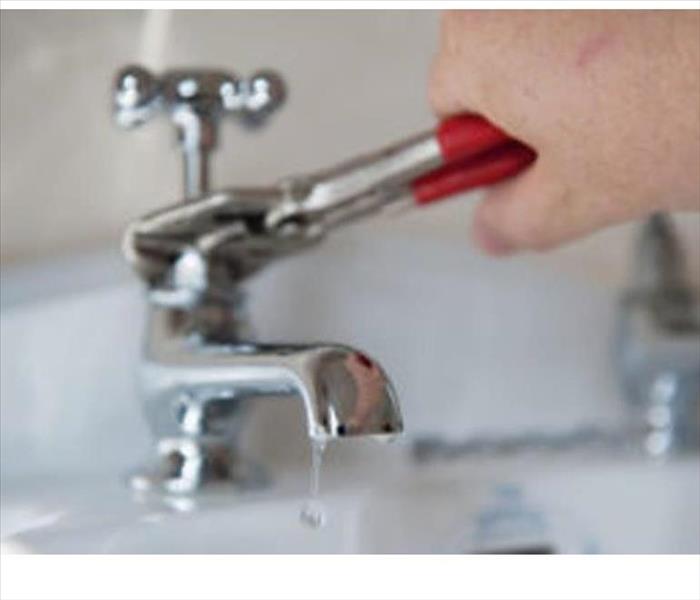 When water floods, Give the Professionals at SERVPRO of South Garland a call at (972)278-7871
When water floods, Give the Professionals at SERVPRO of South Garland a call at (972)278-7871
Learn how to prevent household water loss with these tips!
Water is a precious resource. It’s important to conserve water. Not only does saving water help save more water for drinking and agriculture, but it also helps to keep your water bill low. In turn, it helps you to save money. However, sometimes you’re unaware of the fact that you’re using water. Sometimes you’re a victim of water loss. Check out these ways that you can help prevent water loss in your home.
Inspect Home Appliances.
Appliances like your air conditioner, washer, and refrigerator all require water usage. However, it’s important to inspect your appliances regularly to ensure they’re working properly. A worn or broken hose can quickly turn into a disaster. Avoid any unnecessary water loss and replace your appliance hoses when needed. Additionally, pay attention to your ice maker. The hose that connects to your water line often times can lead to water loss.
Be Vigilant of Your Home’s Plumbing.
A plumbing leak can wind up causing serious damage to your home. Plus, it can cause your water bill to skyrocket. Check your home periodically for any signs of leaks. If you notice any water stains, rusty water, loud noises coming from your pipes, or spikes in your water bill, have a professional come to inspect your home’s plumbing. You likely have a leak that’s causing serious water loss.
When it comes to your home, ensure that you do your part to prevent water loss. You’ll save money and help in water conservation efforts, and you’ll contribute to reducing your risk for household water damage. Knowing who to call in an emergency situation can be crucial to keeping your items from further damage. SERVPRO of South Garland is your one stop to stop the water damage in your home or business. Contact us at (972)278-7871 for more information.
SERVPRO of South Garland and Flood Damage
11/8/2016 (Permalink)
 With flood waters rising do not be caught with out a plan. Give us a call today (972)278-7871 SERVPRO of south garland is here to help.
With flood waters rising do not be caught with out a plan. Give us a call today (972)278-7871 SERVPRO of south garland is here to help.
In Texas flooding can be common, even multiple occurrences in one year in some places when you say the woods “Flood Damage” people tend to think entire neighborhoods under water or feet deep of water in their basements. Homeowner insurance policies rarely cover Flood damage, so find out if you are at risk for a flood, and talk to you insurance to find a good flood policy to cover your home, as mitigation and repairs can be very costly.
SERVPRO of South Garland is an expert in mitigating flood damages to your home. The thing that most surprises clients is the many different ways a flood can keep causing damage to the home even after all of the water is removed.
Sewage and plumbing: if the home stays under water for to long the plumbing system can be put under a lot of stress and be overwhelmed and could be damaged, this can cause a plethora of problems including but not limited to joints breaking, sewage backups, and clogged pipes. Septic tanks can be affected in the same way, the cleanup gets more expensive and much more intense when this happens.
Microbial Contamination: this contamination can cause health hazards, especially is sewage get into your home. This microbial life can impact breathing, and cause other health concerns with your intestines, kidneys and even your liver.
Mold and Mildew: if left untreated mold and mildew produce mycotoxins that can cause respiratory problems the can drive you from your home, many times when mold and mildew get into hard porous materials like sheetrock, the materials have to be removed and properly disposed of. Mold can be particularly hazardous for people with asthma or other respiratory issues.
Odor: Most people may think that this is a small thing in the big picture; however, many people can be allergic to just the smell and it can cause them to get sick. The smell may be an indicator of a more significant problem developing where you cannot see it, if left untreated you may get to a point that you cannot live in it, definitely not be able to sell it.
Electrical system: while the water may not reach most of the electrical system in most floods floor plugs and wall plugs near the floor are at a high risk of being compromised by flooding. If these outlets are affected by water they will need to be inspected by our SERVPRO professionals in order to make sure that there is not a risk for fire when the power is turned back on.
Locally Owned Company with National Resources
Flood water needs to be removed quickly and is a dangerous threat to you and your home. SERVPRO of South Garland understands that this is only the first step. Other hazards may have to be addressed before you are safe again in your own home. To begin the process or if you want to schedule an inspection to help prevent problems in the future, call us today at (972) 278-7871
Rapidly Removing Water Limits Damage
11/7/2016 (Permalink)
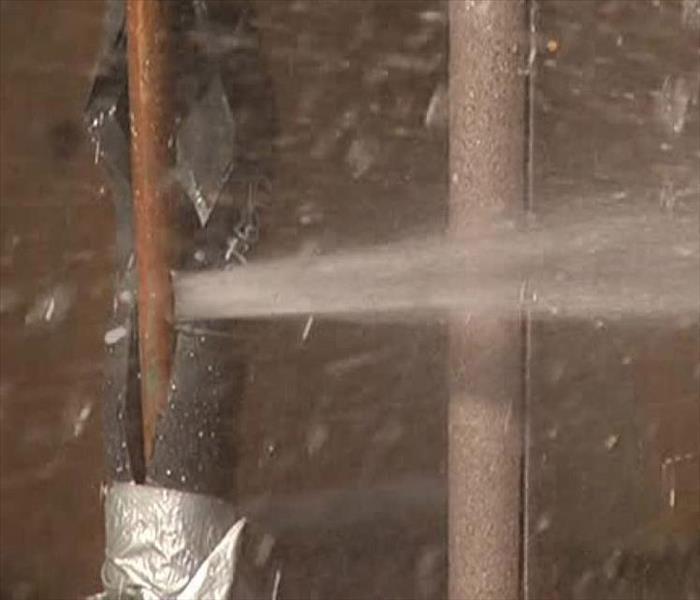 this is what happens when a pipe is put under to much stress
this is what happens when a pipe is put under to much stress
Quickly removing water significantly reduces the damage that it does to your possessions.
Burst Pipes, broken valve, leaking drain, busted water heater, or a leaking roof can lead to significant water damage in your homes.
SERVPRO' s Expertise Saves Homeowners Money and headaches with quick and efficient Water Extraction.
At this time of year winter and, spring in Texas do not let up on the severe weather, just last year we had a horrible tornado hit just a few days before Christmas, devastating many neighborhoods in our area. And it seems just when you start to dry out another round of storms is on its way. Water damage from weather, broken plumbing, or improper drainage can be a significant blow to a homeowner.
At SERVPRO we know how important it is to you to be back in your home as quickly as possible, to eliminate the risk of more damage we need to get the water out of you home as quickly as possible, depending on the amount of space in your home that was flooded and the amount of water released into your home this process can take a few days to a week or more, our team of technicians are IICRC in water removal mitigation and works fervently to make sure the process is as painless and efficient as possible for you
Each locally owned office maintains a 24-hour response team specializing in water removal. Damage for standing water in the home starts immediately and any standing water needs to be removed as soon as possible. SERVPRO owns and keeps on hand a variety of pumps and water extractors that are designed for residential homes and commercial buildings, each office maintains generators to support the teams and equipment because what is the point of having equipment if the power grid is knocked out from the storm and not having a way to power them.
After the standing water has been removed our technicians apply and anti-microbial solution, and utilize a series of fans and dehumidifiers based of the size of each affected room and the amount of open air in the house. This is to remove the excess moisture in the affected materials and remove the humidity to prevent any anti-microbial growth (these can range from just bad smells to mold or even the decomposition of materials). The technicians also may use specialized mat systems for wood floors, and set pads under furniture to minimize staining of the carpet and to protect the furniture. Ink may bleed and run from cloth or paper good and most of the time this makes them almost impossible to salvage, but our highly trained technicians may be able to if they get to them quickly enough.
If you are concerned about preventing damage, you can contact us for a free inspection or if you have need of our services now, call us at (972) 278-7871. As a locally owned business, SERVPRO of South Garland is dedicated to restoring the homes of our neighbors.
Appliance Overflow Cleanup Services in Dallas
3/3/2016 (Permalink)
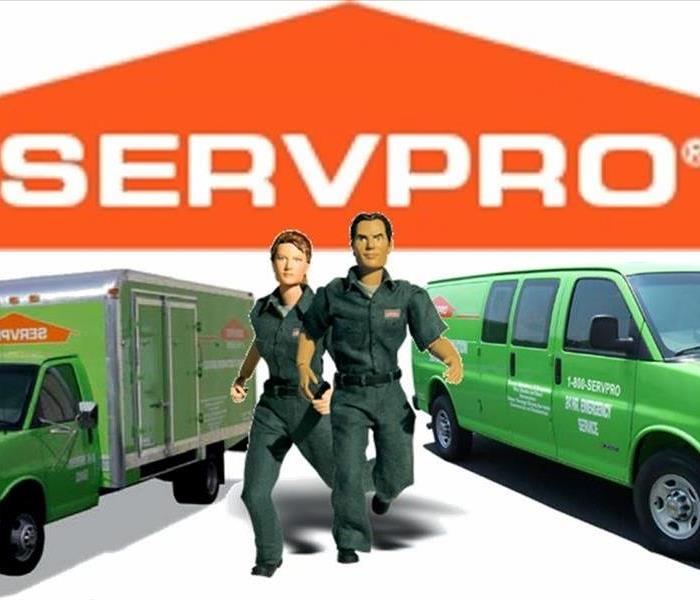 SERVPRO of South Garland
972-278-7871
SERVPRO of South Garland
972-278-7871
Cleanup for Appliance Overflows
All appliances which utilize water should be inspected on a regular basis to assess the need for replacement or repairs. What starts as a slow drip or leak can possibly lead to appliance flooding, water damage, and even mold damage.
SERVPRO of South Garland offers water damage restoration, water extraction, structural drying, and appliance leak cleanup for:
- Water Heater Burst
- Washing Machine Overflow or Hose Burst
- A/C Unit Drain Overflow
- Refrigerator and Ice Maker Overflow
- Dishwasher Overflow
Contact SERVPRO of South Garland if you notice appliance leaks, flooding, or failure. One of our highly trained professionals will be dispatched to your location in our Dallas service area.
Why Choose SERVPRO?
- 24/7 Emergency Service
- On Site In About An Hour
- IICRC Certified Restoration Crews
- Insurance Billed Direct
Cleanup Services for Plumbing Overflow
We also offer services for water damage caused by leaky pipes, burst pipes, frozen pipes, and clean up from drain, sink, toilet, and water heater overflows.
Our plumbing overflow cleanup services include:
- Burst and Frozen Pipe Overflow Cleanup
- Drain & Sink Overflow Cleanup
- Toilet Overflow Cleanup
- Shower & Tub Overflow Cleanup
Our water cleanup technicians are highly trained and certified through the Institute of Inspection, Cleaning and Restoration Certification (IIRC). Call SERVPRO of South Garland today at 972-278-7871 for residential and commercial appliance and plumbing overflow cleanup services in our Dallas service area.
24/7 Water, Fire, and Storm Damage Restoration
Contact SERVPRO of South Garland for water, fire, and storm damage restoration services in Dallas, Garland, Richardson, Mesquite, Rockwall, Rowlett, and other surrounding areas.
Help for Dallas Residents When Washing Machine Hoses Fail
12/8/2015 (Permalink)
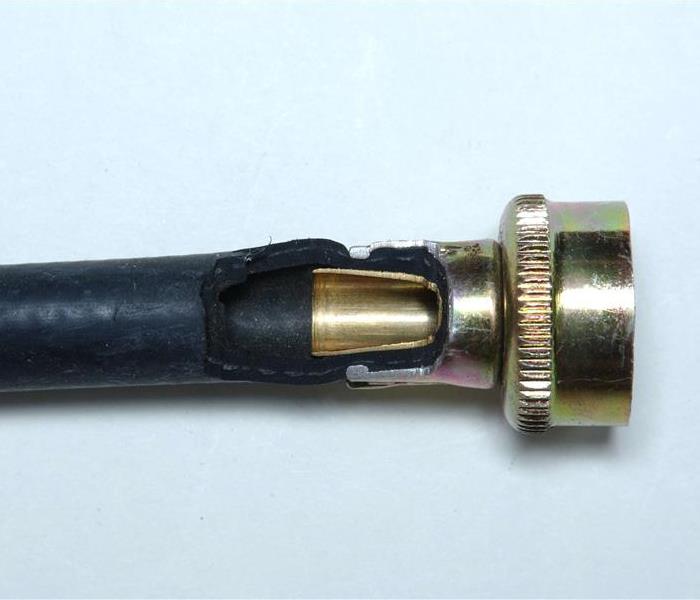 Dallas, TX - Servpro of South Garland
Dallas, TX - Servpro of South Garland
Water damage caused by washing machines is one of the most common claims for home insurers. With time, even a properly installed washing machine hose will fail and lead to leaks and floods. This failure can be due to any number of reasons including age, faulty materials, faulty design, or errors during installation.
Water can flood out of a burst washing machine hose at a rate of 650 gallons per hour causing catastrophic flooding to a home. This flooding will continue until someone turns off the main water supply line due to the fact that supply lines to washing machines are always “on.”
Most hoses are made of reinforced rubber or polymer and these materials lose their resiliency with age. Failure rates for these hoses increase dramatically when they are over 5 years of age. In fact, the average age of a failed washing machine hose is 8 years.
The most common installation error is leaving insufficient room between the machine and the wall causing a crack or kink in the hose.
If you experience leaking or flooding due to a burst washing machine hose, first turn off the water and then call us at 972-278-7871. SERVPRO of South Garland and our professionally trained staff are always here to help 24/7. We can remediate the water damage to your home and make it “Like it never even happened.”
Dallas - We are "Always Here to Help" If You Experience Water Heater Overflow
11/7/2015 (Permalink)
 SERVPRO of South Garland will have your house back to normal in no time after a water heater overflow. Call us today at (972) 278-7871
SERVPRO of South Garland will have your house back to normal in no time after a water heater overflow. Call us today at (972) 278-7871
Water Heater Overflow Cleanup
One of the most prevalent causes of indoor flooding is water heater overflows. These water heaters are usually located in basements, attics, garages, or a utility room closet; places people don't go very often. So, if a burst or leak happens, the homeowner or tenant likely would not find the problem until after a significant water intrusion has already occurred. If this were to happen to you, you'll want to stay calm, shut off the heater and water, and contact the SERVPRO of South Garland professionals for help.
SERVPRO of South Garland has the professionals who are equipped to handle a water heater overflow. They have the knowledge, tools, and experience to deal with the situation safely and effectively whether it's your home or workplace that is in jeopardy.
How Do Water Heater Overflows Happen?
Water heater related floods usually occur due to a worn out seal or gasket, or from a leak in an older tank that rusted through. Sometimes a tank can actually explode or burst in a violent and dangerous manner. This could cause serious harm to anyone who is in the immediate vicinity of the water heater at the time of the explosion. Leaks are more common than bursts and have the potential to flood large portions of a home or basement if the leaking is undetected for days on end.
A malfunctioning thermostat is usually the cause of a water heater burst. These thermostats are used to measure the temperature inside the tank to turn the heating elements off and on so that a preset desired temperature range can be maintained. In the event of a broken thermostat, the heating system inside the tank could stay on indefinitely and cause the water to boil. This boiling water turns into steam and builds up internal pressure inside the tank. This internal pressure will build up and eventually reach a point where the tank cannot hold it, which will result in a burst or even explosion.
When such a burst occurs, steam and boiling water rush out of the tank, while cold water from the intake line flows into the tank. Normally, the line will shut itself off, preventing water entry when the tank if full. However, in this situation, the burst tank is never full because of the continual leaking, and the water from the main line flows through indefinitely. Water is entering the tank only to leak back out and flood the area around and below the water heater. The only upside to this scenario is that someone will likely hear the loud burst and investigate and discover the problem before too much damage has occurred and remediation can be started.
A leak, on the other hand, operates quietly and floods your home, basement, or workplace a little at a time. Usually, it will happen when one of your heating tank's fittings becomes damaged or corroded. This can provide a gap that allows water to escape. This flooding is not violent like a burst or explosion, but it can still be extremely destructive to property and sometimes dangerous to humans or pets. Regular maintenance and inspections of your water heater will increase awareness of possible problems. A professional can replace the anode, flush the corrosion from your tank, as well as check all valves and gaskets for problems or warning signs.
What are the Hazards of Water Heater Overflows?
With the added elements of high temperature and late detection, the number of threats with water heater flooding exceeds that of normal flooding. Here are some things to look out for in the event of a water heater overflow:
Hot water burns – The initial burst of water from a heater is scalding hot, so be sure not to rush in, especially if you see steam. Use protective clothing before attempting anything. Ideally, call SERVPRO of South Garland to do the job for you. (972) 278-7871Electrocution by water – A flooded basement carries the risk of having the water making contact with power outlets and exposed wiring. When this happens, the floodwater carries a strong electric current that’s enough to kill anyone. When you see your basement flooded, resist the impulse to dive into the water in an attempt to shut the leaking heater down. Contact SERVPRO of South Garland for help. Our professionals will be able to determine whether there’s an electrical threat or not. They’ll know the safest procedure for shutting down the water source and containing and extracting the water from your property.Potential fire starter – Flooding doesn’t just create an electrical hazard, it can also short-circuit your electrical system and create sparks. Faulty electrical wiring is one of the most common causes of fire.Water damage – When the water spills beyond the immediate surroundings of the heater and gets into your living and work spaces, the threat of water damage arises. Water can ruin carpets, damage wood, corrode metals and toast expensive appliances and machinery.Mold growth – Mold spores can activate in places where there’s sufficient moisture and organic matter to sustain them. If your property was flooded by an overflowing heater, there’s a good chance that mold growth can follow suit. While seemingly harmless at first glance, mold can irritate our noses and skin when its spores are inhaled. Under certain conditions, mold colonies can turn black and toxic. The poison they produce has been linked to neurological disorders and even cancer.Contact SERVPRO of South Garland now at (972) 278-7871
A water heater overflow is an emergency that should be addressed rapidly and decisively. The longer you wait the worse it can get and attempting to repair the water heater and clean up the water yourself could be dangerous and risky. Contact an experienced professional through SERVPRO of South Garland today for a quick and easy resolution to your problem. "We're Always Here to Help" 24 hours a day, seven days a week, all year long.




 24/7 Emergency Service
24/7 Emergency Service















